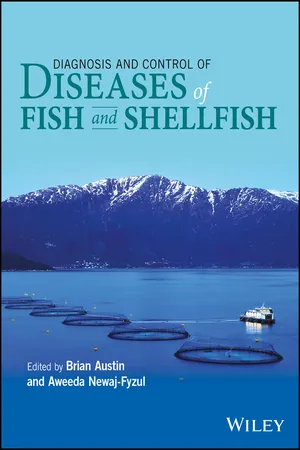
Diagnosis and Control of Diseases of Fish and Shellfish
- English
- ePUB (mobile friendly)
- Available on iOS & Android
Diagnosis and Control of Diseases of Fish and Shellfish
About this book
There has been a continual expansion in aquaculture, such that total production is fast approaching that of wild-caught fisheries. Yet the expansion is marred by continued problems of disease. New pathogens emerge, and others become associated with new conditions. Some of these pathogens become well established, and develop into major killers of aquatic species.
Diagnosis and Control of Diseases of Fish and Shellfish focuses on the diagnosis and control of diseases of fish and shellfish, notably those affecting aquaculture. Divided into 12 chapters, the book discusses the range of bacterial, viral and parasitic pathogens, their trends, emerging problems, and the relative significance to aquaculture. Developments in diagnostics and disease management, including the widespread use of serological and molecular methods, are presented. Application/dose and mode of action of prebiotics, probiotics and medicinal plant products used to control disease are examined, as well as the management and hygiene precautions that can be taken to prevent/control the spread of disease.
This book will be a valuable resource for researchers, students, diagnosticians, veterinarians, fish pathologists and microbiologists concerned with the management of diseases of fish and shellfish.
Frequently asked questions
- Essential is ideal for learners and professionals who enjoy exploring a wide range of subjects. Access the Essential Library with 800,000+ trusted titles and best-sellers across business, personal growth, and the humanities. Includes unlimited reading time and Standard Read Aloud voice.
- Complete: Perfect for advanced learners and researchers needing full, unrestricted access. Unlock 1.4M+ books across hundreds of subjects, including academic and specialized titles. The Complete Plan also includes advanced features like Premium Read Aloud and Research Assistant.
Please note we cannot support devices running on iOS 13 and Android 7 or earlier. Learn more about using the app.
Information
Chapter 1
Introduction
… a disease is the sum of the abnormal phenomena displayed by a group of living organisms in association with a specified common characteristic or set of characteristics by which they differ from the norm of their species in such a way as to place them at a biological disadvantage. (Campbell et al., 1979)
- Sporadic diseases, which occur sporadically in comparatively small numbers of individuals in a population.
- Epidemics/Epizootics, which are large-scale outbreaks of communicable disease occurring temporarily in limited areas.
- Pandemics/Panzootics, which are large-scale outbreaks of communicable disease occurring over large areas.
- Endemics/Enzootics, which are diseases persisting or reoccurring as low-level outbreaks in defined areas.
Conclusion
- The list of parasitic, bacterial and viral pathogens continues to grow, although the significance of some organisms to pathology is difficult to ascertain – are they truly parasite/pathogens, secondary invaders or contaminants?
- There has been considerable improvement in the taxonomy and hence diagnosis (accuracy and sensitivity) of many pathogens, particularly involving the sequencing of the 16S rRNA gene.
- Disease control has progressed from therapeutic to prophylactic, and now involves a wide range of approaches including vaccines, non-specific immunostimulants, prebiotics, probiotics and plant products.
References
- Campbell, E.J.M., Scadding, J.G. and Roberts, M.S. (1979) The concept of disease. British Medical Journal, 2, 757–762.
- Kinne, O. (1980) Diseases of Marine Animals, vol 1. General Aspects, Protozoa to Gastropoda, John Wiley & Sons, Chichester.
- Metselaar, M., Thompson, K.D., Gratacap, R.M.L., et al. (2010) Association of red-mark syndrome with a Rickettsia-like organism and its connection with strawberry disease in the USA. Journal of Fish Diseases, 33, 849–858.
- Stevenson, L.H. (1978) A case for bacterial dormancy in aquatic systems. Microbial Ecology, 4, 127–133.
Table of contents
- Cover
- Title Page
- Copyright
- Table of Contents
- List of Contributors
- Preface
- Chapter 1: Introduction
- Chapter 2: Bacterial Diagnosis and Control in Fish and Shellfish
- Chapter 3: Complexities of Diagnostics of Viruses Affecting Farmed Aquatic Species
- Chapter 4: Parasitic Diseases in Aquaculture: Their Biology, Diagnosis and Control
- Chapter 5: Modern Methods of Diagnosis
- Chapter 6: Immunostimulant Diets and Oral Vaccination In Fish
- Chapter 7: Prebiotics and Synbiotics
- Chapter 8: Probiotics for Disease Control in Aquaculture
- Chapter 9: Use of Medicinal Plants in Aquaculture
- Chapter 10: Antibiotics and Disinfectants
- Chapter 11: Management Techniques and Disease Control
- Chapter 12: Conclusions
- Index
- End User License Agreement